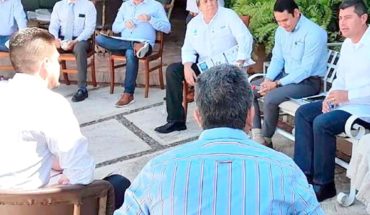“As in a film/after the great earthquake/There is always a child/who does not die”, Robert Bolaño.
The route of the author of 2666 and the Wild detectives drawn by Nibaldo Acero (Santiago, 1975) prowls from poetry, revealing a versatile multifaceted Bolaño, in constant dialogue with his writing, whenever we find concatenations in it, Intratextualities, internal circuits, which surpass the rigid categories of prose or poetry. Oneness, po-ethics of existing, transit through Mexico City, Barcelona, Girona, Blanes, all the imaginary infrarealist and Posinfrarrelista.
As claimed by Rubén Medina, a infrarealist poet and interviewed by the author, in the Prologue: “In this study steel wonders for the place and meaning of Bolaño’s poetry in the whole of his narrative work, for the dimension of his poetry itself and for its transforms Over the years, by the tension that permanently establish poetry and prose. ”
Corresponding to one of the two investigations derived from its doctoral thesis, the route of the Red Children (published by the Mexican publisher slaughterhouse in 2017, and which bears its name for a poem of Bolaño of 1977) is an academic text, by the way, rigorous, which is read Slowly, offering a transdisciplinary look (from the cinema, own imaginary, reflections from post-colonial studies and other critical methodologies), according to the rarity of a writer out of series as Roberto Bolaño.
An author of trenches against the literary mafias and the institution of the specialized critic. An author who is above all a poet even of the hegemonic overexposure of his narrative by the same critique, the Academy and the publishing market.
There he sets up an ethic, says Steel:
“(…) And despite the exclusion for years of his poetry from a rigorous critical discussion, the Chilean author managed to set up a poetic project of such magnitude that makes us speculate on the ethical character of this aesthetic production, especially that of the nineties. Why should we continue to build a poetic manifesto if the prose had already catapulted it to the very center of the Latin American cultural arena? One might ask once again, what is the place of poetry for Bolaño in front of his narrative work? What would be the value of his poetry for himself and for himself? (P. 33).
Poetry as the “engine of its narrative”, which “is fuel that mobilises a whole prosaic machinery”. Poetry as a modern conscience “that makes it a tool of knowledge, transformation and critique, but also of pleasure, of violence contained and fraternity” (p. 35).
Nibaldo Steel proposes a compromised textual analysis, which empathize, which interprets, which is linked; A “synaptic” reading when detecting communicating vessels between poems and narrations (including, for example, reinventing Love and 2666).
We could talk about a transtemporality of the work Bolañeana, as if all the writing was part of a whole, a collaborative process, a “writing of integration” that goes from the past to the future, or from the future to the past, as you want, even temporary jumps, Understanding “the past” as the author’s first production, and the “future” as all the material published posthumously.
The Poetics of Bolaño, in the judgement of steel, are impregnated with Oxímoros, antithesis and Ouróboros, given that fascination with beauty and horror, death, the macabre, which inconveniences the reader, which obliges it to the comprehension through images and contradictory descriptions. In the end, the problems of a modernity located in Mexico as representation, as a symbol of Latin America.
This poetic, in genealogical terms, recognizes three stages: Bolaño Infrarealist (1975 to 1977-78), where “the historical subject goes from being a teenager to an adult aware of the social conflicts of Mexico, Latin America and The Orb”; Bolaño Desterritorializado (Years 80), “which reveals a bitter existentialism, but still, albeit less, hopeful”, “where a modernity settles in its attitude and writing and where the poet seems to gain and to strengthen its modern conscience”; and stage of death (last years), “that manifests the phase of a poetry whose axiomatic perspectives go through the education of beauty for his son Lautaro”, where “perfects the Pedagogical Manifesto for young poets, re-signified in the figure of his son”.
The stages make up the articulation axes of the research, whose title, More than a poem (once again, an inter-and intra-textuality between author and work, between author-work and a reader-critic-steel), is a metaphor about the failure of Utopia, Socialism, Revolution through the figure of the surviving child, intermingling the fragility, tenderness, naivety, resistance, hope, the third World made text “through the lacerated flesh, of the living flesh almost dead, whose scars of colonization have Tajeado our language and Organs “(p. 89).
We also find the exile in addition, the permanent journey, the physical journey, literary, even phantasmagoric, following Baudelaire, Mallarmé, Lihn, Parra, etc., “as an alternator that transforms the street and the body into energy that keeps linked and Convulsed the subject and its history, shaking the circulation of repertoires and forms between his poetry and premature prose, “says Steel.
“The transformative and incessant movement of the poem-voyage-nomadic activates the process of production and of Autofiction, associating in addition and transferring genres, repertoires and elements” (p. 32).
“The flight of prose has its origin in the Dream (delirium) of poetry. The best structured narrative that has more aesthetic pleasure in the work of Bolaño, the most praised, becomes a lyric that Imanta dreams and nightmares; of a infrarrealidad which in turn has been a permanent resistance and integration of a tradition whether it is a trident, Horazeriana, symbolist or romantic, a transformation that has allowed its permanent renovation and its subsequent complex analysis “(p. 164).
Where some critics catalogue the poetry of Bolaño, steel, on the contrary, it recognizes a literary program, a program that inevitably follows a vital trajectory, of joys, Furies, fears and many failures. Self-fiction, yes, but autofiction “of radical energy and intimate morality”, “which sees in itself the possibility of refueling, projecting and staying alive.”
“(…) But I have learned to read this poetry from another place, and supported by the proposed methodology, I could account for a lyric that live and persistently in rabid journey, does not clog those verses that, while sometimes do not dazzle the reader, detonate the deep pain of poverty, failure and loneliness, minimum joys, small pleasures, enough to continue on the battlefield “(p. 254).
“Just as I have no doubt that the Bolaño was a courageous and reckless existence and writing (worth the difference), nor do I hesitate to propose that such bravery does not spring from nothing, that there was certainly an arduous process of comparison of defeats and suffering , of self, autofiction and of identity circuits, where the historical subject incessantly measured the inhabitant subject of his texts, and vice versa, and where the insecurity and the despair made fatherland, and where the fear overflowed the ethical bards, before the Day-to-day socioeconomic instability (p. 184).
A daring bet is that of the route of the red children, but that it is achieved to concretize well in definitive, that brings a different look, another one, a look that does not exhaust in a closed investigation, distant, scientific, but that navigates, not without turbulences, in the Irregular journeys, in the lofty, in the darkness of an author at this high altitude to the condition of myth.
Steel tempts an intuitive, historical knowledge that appeals to one’s own experience, where they inhabit more questions than answers. At the same time with the reader, discarding a status of conceited theorist and megalomaniac, this investigation offers an epistemological overflow, an emancipatory attempt, with a counterhair of an institutionality, refled and denounced by Bolaño during its life, which transformed it In a salon writer, comfortable, sanctified, confiscated, digestible, object of deterministic and traditional analyses.
Nibaldo Steel, the route of the red children. The Poetics of Roberto Bolaño. Ed. Slaughterhouse, 2017. 285 pages.





